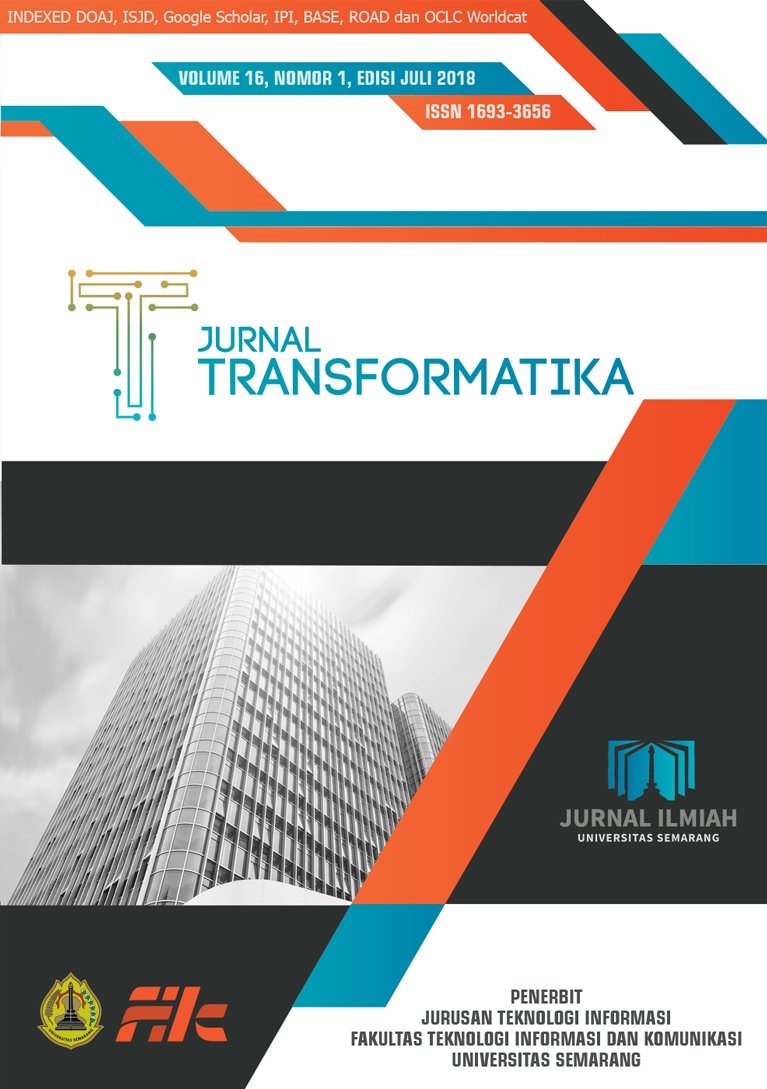Aplikasi Text Mining untuk Klasterisasi Aduan Masyarakat Kota Semarang Menggunakan Algoritma K-means
DOI:
https://doi.org/10.26623/transformatika.v18i2.2362Keywords:
community complaint, text mining, kmeans algorithm, purityAbstract
Social media is a service that is very supportive for government activities, especially in providing openness and community-based government. One form of its implementation is the Semarang City government through the Center for Community Complaints Management (P3M), whose task is to manage community complaints that enter one of the communication channels namely social media twitter. The number of public complaints that enter every day is very varied. This is certainly quite difficult for managers in categorizing complaints reports according to the relevant Local Government Organizations (OPD). This paper focuses on the problem of how to conduct clustering of community complaints. The data source comes from Twitter using the keyword "Laporhendi". Text document data from community complaint tweets was analyzed by text mining methods. A number of pre-processing of text data processing begins with the process of case folding, tokenizing, stemming, stopword removal and word robbering with tf-idf. In conducting cluster mapping, clustering algorithm will be used in dividing the complaint cluster, namely the k-means algorithm. Evaluation of cluster results is done by using purity to determine the accuracy of the results of grouping or clustering.
References
M. Afzali and S. Kumar, Text Document Clustering : Issues and Challenges, 2019 Int. Conf. Mach. Learn. Big Data, Cloud Parallel Comput., pp. 263 268, 2019.
X. et al Wu, Top 10 algorithms in data mining, Knowl. Inf. Syst., vol. 14, pp. 1 37, 2008.
S. Karyadi and H. Yasin, Analisis Kecenderungan Informasi Dengan Menggunakan Metode Text Mining, J. Gaussian, vol. 5, pp. 763 770, 2016.
D. S. Indraloka, B. Santosa, D. Matematika, F. Matematka, P. Alam, I. Teknologi, and S. Nopember, Penerapan Text Mining untuk Melakukan Clustering Data Tweet Shopee Indonesia, J. Sains dan Seni, vol. 6, no. 2, pp. 6 11, 2017.
R. Melita, V. Amrizal, H. B. Suseno, T. Dirjam, P. Studi, T. Informatika, and F. Sains, Penerapan Metode Term Frequency Inverse Document Frequency (Tf-Idf) Dan Cosine Similarity Pada Sistem Temu Kembali Informasi Untuk Mengetahui Syarah Hadits Berbasis Web ( Studi Kasus : Syarah Umdatil Ahkam ), J. Tek. Inform., vol. 11, no. 2, 2018.
R. K. Dinata, N. Hasdyna, and N. Azizah, Analisis K-Means Clustering pada Data Sepeda Motor, Informatics J., vol. 5, no. 1, 2020.
J. Teknik, I. Fik, and J. N. N. Semarang-, Klasterisasi Proses Seleksi Pemain Menggunakan Algoritma K-Means, Universitas Dian Nuswantoro, 2015.
S. Defiyanti, M. Jajuli, T. Informatika, F. Ilmu, K. Universitas, and S. Karawang, Implementasi Algoritma K-Means Dalam, J. Ilm. Inf. Terap., vol. I, no. 2, pp. 62 68, 2015.
A. K. Wardhani, Implementasi Algoritma K-Means Untuk Pengelompokkan Penyakit Pasien Pada Puskesmas Kajen Pekalongan, J. Transform., vol. 14, pp. 30 37, 2016.
K. R. Prilianti and K. Kunci, Aplikasi Text Mining untuk Automasi Penentuan Tren Topik Skripsi dengan Metode K-Means Clustering, J. Cybermatika, vol. 2, no. 1, pp. 1 6, 2014.
Downloads
Published
Issue
Section
License
Authors who publish with this journal agree to the following terms:
- Authors retain copyright and grant the journal right of first publication with the work simultaneously licensed under a Creative Commons Attribution License that allows others to share the work with an acknowledgement of the work's authorship and initial publication in this journal.
- Authors are able to enter into separate, additional contractual arrangements for the non-exclusive distribution of the journal's published version of the work (e.g., post it to an institutional repository or publish it in a book), with an acknowledgement of its initial publication in this journal.
- Authors are permitted and encouraged to post their work online (e.g., in institutional repositories or on their website) prior to and during the submission process, as it can lead to productive exchanges, as well as earlier and greater citation of published work.

Transformatika is licensed under a Creative Commons Attribution 4.0 International License.


